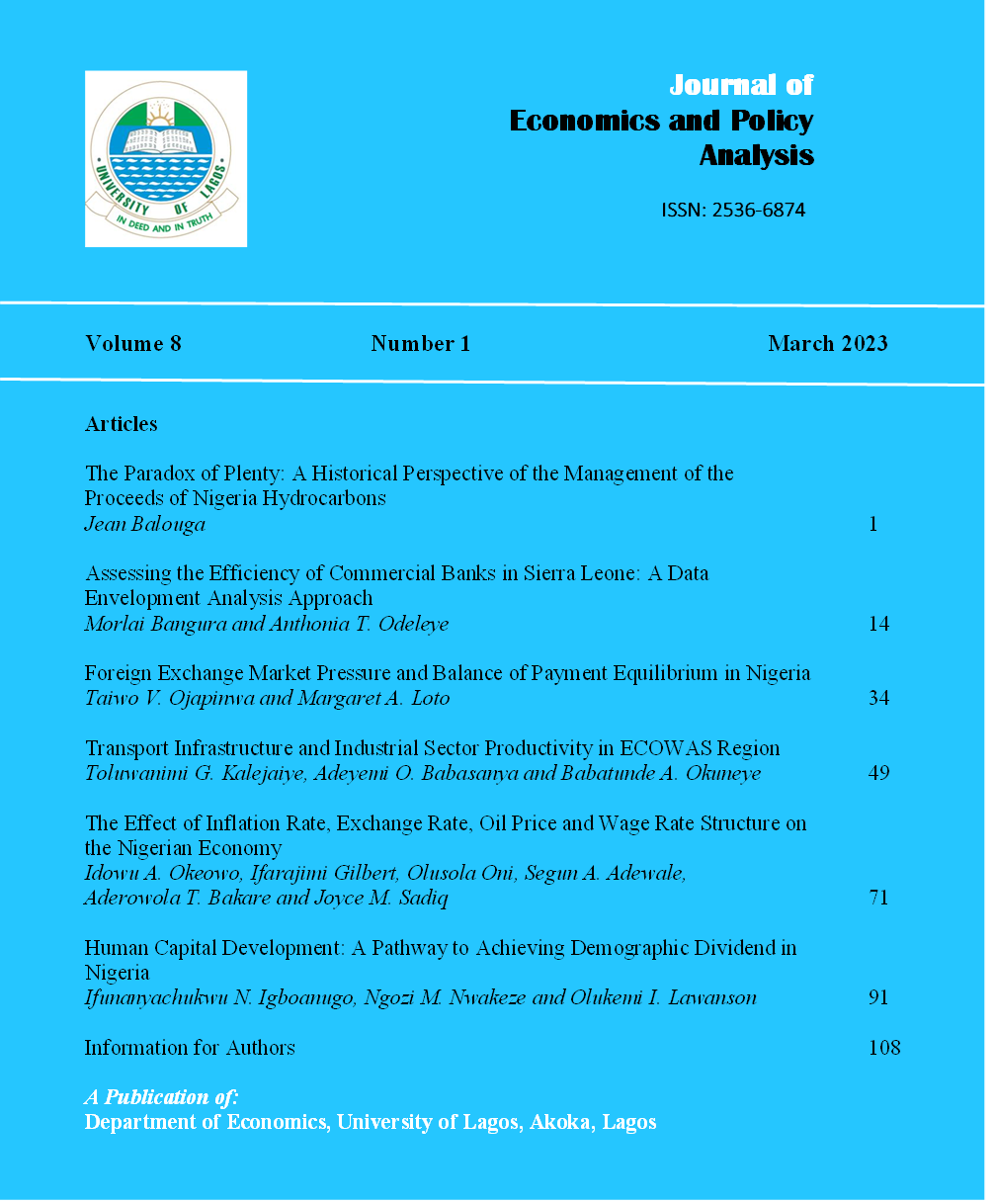Foreign Exchange Market Pressure and Balance of Payment Equilibrium in Nigeria
Abstract
Within the monetary and the balance of payment approaches which established that large exchange rate fluctuations may be detrimental to economic performance, this study examined the response of exchange market pressure (EMP) on balance of payment equilibrium in Nigeria. Adopting Autoregressive Distributive Lag (ADRL), this study found that EMP had a negative and significant impact on balance of payment in Nigeria. This implies that exchange rate depreciation increased pressure on external reserve and causes deficit in the balance of payment. To correct for this, government may need to adopt measures such as economic diversification anchored on comparative advantage, rebuild the productive sectors – manufacturing and industrial to achieve higher capacity untilisation and productivity and competitvive export, encourage local refining of petroleum products, promote fiscal and monetary discipline and harmony and create an enabling environment for productive capital inflows, especially foregn direct investment.
References
Agundu, P. U. C., Akani, W.H., & Kpakol, F. C. (2013). Exchange rate dynamics and balance of payments repositioning in Nigeria. European Journal of Business and Management, 5(29), 84-91.
Central Bank of Nigeria (2020). Annual report, The global economy chapter.
Central Bank of Nigeria (2020). Annual report, External sector development, 1(1), March.
Central Bank of Nigeria (2019). Annual report, Resource data, 1(1), March.
Eichengreen, B., Andrew R., & Charles W. (1995). Exchange market mayhem: The antecedents and aftermath of speculative attacks. Economic Policy, 21, 249 – 312.
Eichengreen, B., Andrew R., & Charles W. (1994). Contagious Currency Crises: First Tests. Scandinavian Journal of Economics, 98, 463–484.
Engle, R. F., & Granger, C. W. J. (1987). Co-integration and error correction: Representation, estimation, and testing, Econometrica, 55(2), 251-276.
Feldkircher, M., Horvath, R., & Rusnak, M. (2014). Exchange market pressures during the financial crisis: A Bayesian model averaging evidence. Journal of International Money and Finance, 40, 21-41. https://doi.org/10.1016/j.jimonfin.2013.08.021
Girton, L., & Roper D. (1977). A monetary model of exchange market pressure applied to the postwar Canadian experience. American Economic Review, 67, 537-548.
Iyoha, M., & Ekanem, O.T. (2002). Introduction to econometrics. Mareh Publishers, Benin City, Nigeria.
Johansson, A., & Juselious, (1990). Maximum likelihood estimation and inference on co-european scientific integration with application to the demand for money, Oxford Bulletin of Economics and Statistics, 52, 169-209.
Khan, M.S. (1991). Response of the equilibrium real exchange rate to real disturbances in developing countries, World Developments 20(9), 1325-1334.
Krugman, P. (1979). A model of balance-of-payments crises. Journal of Money, Credit and Banking, 11(3), 311-325.
Mogaji, P.K (2017). Empirical assessment of exchange market pressure within the West African Monetary Zone. Online at https://mpra.ub.uni-muenchen.de/98771/ MPRA Paper No. 98771.
Odili, O. (2014). Exchange rate volatility, stock market performance and Foreign Direct Investment in Nigeria. IOSR Journal of Economics and Finance, 4(6), 21-30.
Oladipupo, A.O., & Ogebenovo, F. O. (2011). Impact of exchange rate on balance of payment in Nigeria. An International Multidisciplinary Journal, 5(4), 73-88.
Pearson, M.H., Shin Y., & Smith, J.R. (2001). Bounds testing approach to the analysis of level relationships. Journal of Applied Economics, 16, 289-326.
Pesaran M.H., & Shin Y., (1999). An autoregressive distributed lag modeling approach to cointegration analysis, In: S., Strom, A., Holly, & P., Diamond (eds.), Centennial volume of Rangar Frisch, Cambridge University Press, Cambridge, (1999).
Phillips P., & Perron P. (1988). Testing for a unit root in time series regression. Bimetrika, 75, 335-346.
Weymark, D. (1995). Estimating exchange market pressure and the degree of exchange market intervention for Canada. Journal of International Economics, 39: 273- 295.


